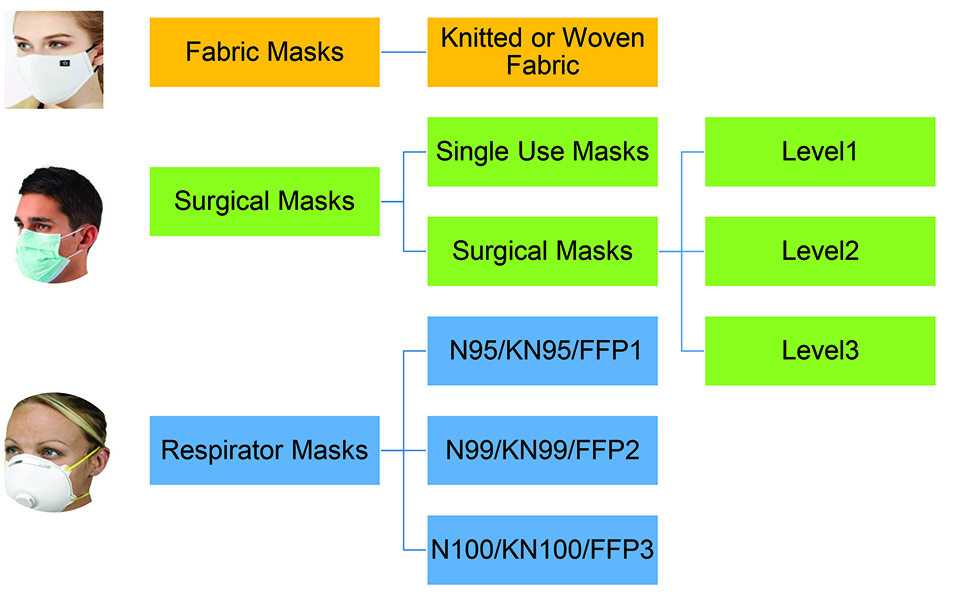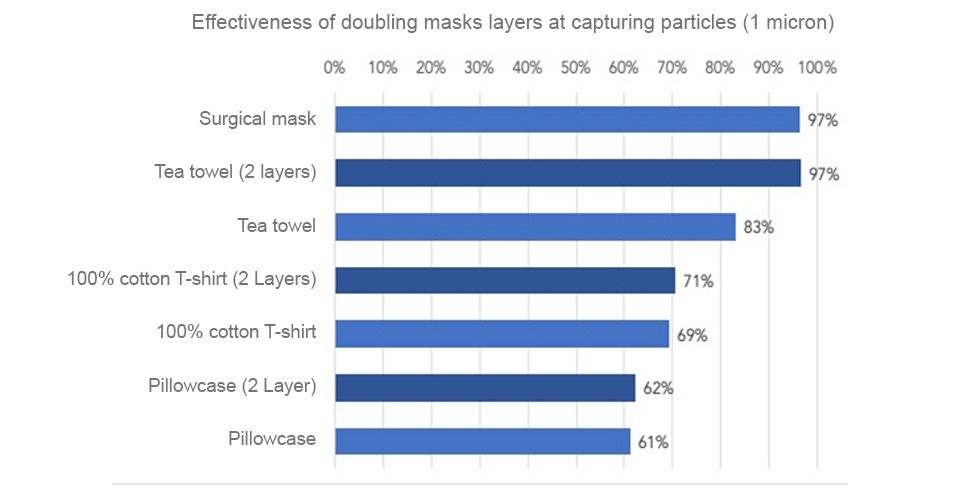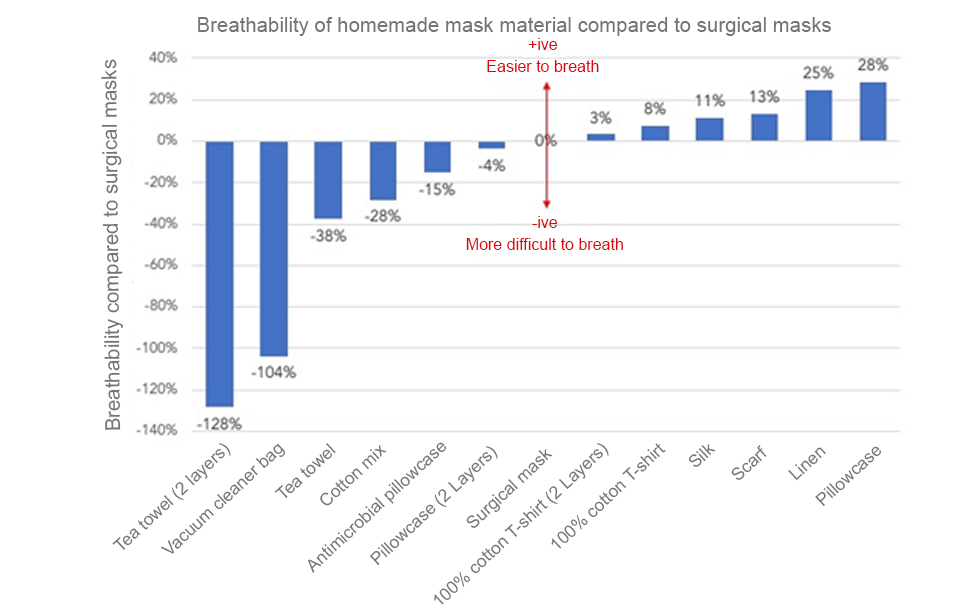
Date: 27 April 2020
Recent research suggests that the coronavirus may survive on airbone aerosols for a few hours, although it also can be spread through larger respiratory droplets emitted through a cough or a sneeze. There is a possibility that there will be a shortage of surgical masks in hospitals during Covid19 pandemic. For this reason, the Centers for Disease Control Prevention (CDC) now recommends using cloth face coverings to help slow the spread of the coronavirus. But what material offers the most protection?
While medical grade masks are hold for healthcare workers, we want to raise awareness and investigate the protection levels of cloth masks as an alternative for public use.
Face Masks & Respirators:

Surgical Masks:
A loose-fitting, disposable device that creates a physical barrier between the mouth and nose of the wearer and potential contaminants in the immediate environment. Made in different thicknesses and with different ability to protect from contact with liquids. These properties may also affect breatheability and protection level. Effective in blocking splashes and large-particle droplets. Does not filter or block very small particles in the air that may be transmitted by coughs, sneezes, or certain medical procedures.
Respirators:
Respiratory masks have an efficiency rating given by the National Institute for Occupational Health and Safety (NIOSH). It means that this mask filters out 95% of (N) on-oil particles that are larger than.3 microns (.00003 cm) for N95 mask.
Respiratory Masks Protect You From:
- Dust
- Pollution
- Bacteria
- Viruses
- Allergens
Do Not Protect You From:
- Oil-based substances
- Gases
Fabric Masks:
Many traditional textile manufacturers are looking for ways to help and willing to temporarily switch their production to reusable textile masks, as the standard nonwoven materials are in extremely short supply due to the unexpected hike in demand. Scientists are testing everyday items to find the best protection from coronavirus. Pillow cases, flannel pajamas and origami vacuum bags are all candidates.
Performance Evaluations of Masks:
- BFE (Bacterial Filtration Efficiency)
Measures how well the mask filters out bacteria when challenged with a bacteria-containing aerosol. Moderate and high protection masks have bacterial filtration rates of 98% to greater than 99%.
- PFE (Particle Filtration Efficiency)
Measures how well a mask filters sub-micron particles with the expectation that viruses will be filtered in a similar manner. The higher the percentage, the better the mask efficiency. ASTM F2100-07 specifies that a particle size of 0.1 micron be used.
- Fluid Resistance
Reflects the mask's ability to minimize the amount of fluid that could transfer from the outer layers through to the inner layer as the result of a splash or spray
- Pressure Differential (Delta P)
Measures the air flow resistance of the mask and is an objective measure of breathability. Masks with a Delta P of less than 4.0 are considered acceptable, while masks with a Delta P less than 2.0 would be considered "cool".
- Flammability
Operating rooms contain sources of oxygen and other gases used for anesthesia, and there are potential fire hazards from electrosurgical procedures such as lasers or cautery equipment. All products used within the operating room, including face masks, are tested for flame resistance

Can Fabric Mask Provide Protection?
A research team from Missouri S&T, has tested the various fabrics and materials using a scanning mobility particle sizer, which measures particle size and concentration. They then compared the “filtration efficiency” of multiple layers of each material against different aerosol particle sizes, ranging from a few nanometers to over 400 nanometers.
Researchers found that the layers of scarves and bandannas did a poor job of filtering out aerosols. Pillowcase fabric fared somewhat better, depending on thread count. A 600-count pillowcase filters better than a 400-count one, the researchers determined.
What the test team found was that the masks’ effectiveness varied widely.
They also found that when certain common fabrics were used, two layers offered far less protection than four layers.
- A 600 thread count double layer pillow case captured 22%
- A 600 thread count 4-layer-pillow case captured nearly 60%
- A thick woolen yarn double layer scarf filtered 21%
- A thick woolen yarn 4-layer- scarf filtered 48.8%
- A 100 percent cotton double layer bandanna did the worst, capturing only 18.2%
- A 100 percent cotton 4-layer-bandanna capturing 19.5%
As per the different research studies, the best homemade masks were as good as surgical masks or slightly better, testing in the range of 70 to 79 percent filtration. Homemade masks that used lighter weight fabric tested as low as 1 percent filtration.
In another research study, experts tested particle filtration vs breathability. Although the dish cloth and the vacuum bag captured the most particles, they were also the hardest to breath through. With two layers, the dish cloth was over twice as hard to breathe through as the surgical mask.


Conclusion
Not surprisingly, the surgical mask performed best, capturing 97% of the 1-micron bacteria. Yet every single material filtered out at least 50% of particles. The answer lies in breathability. How easy it is to breathe through your mask is an important factor that will affect how comfortable and therefore how long you wear your mask.
As the goal is to produce masks as much as in a short time, so some of garment factories switched their facilities to produce masks and they use three-layer jersey cotton fabric for mask production. It is unclear how effective these masks will be against the corona virus.
Currently, it seems difficult to meet all performance expectations in fabric masks, even if the filtration problem is solved, breathability remains a question mark. However, as a result of R&D and expedited research studies, should we say that the fabric might meet all the performance criteria in the mask in the future?